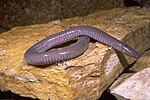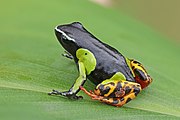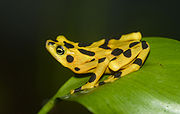Portal:Amphibians
Amphibians are ectothermic, anamniotic, four-limbed vertebrate animals that constitute the class Amphibia. In its broadest sense, it is a paraphyletic group encompassing all tetrapods excluding the amniotes (tetrapods with an amniotic membrane, such as modern reptiles, birds and mammals). All extant (living) amphibians belong to the monophyletic subclass Lissamphibia, with three living orders: Anura (frogs), Urodela (salamanders), and Gymnophiona (caecilians). Evolved to be mostly semiaquatic, amphibians have adapted to inhabit a wide variety of habitats, with most species living in freshwater, wetland or terrestrial ecosystems (such as riparian woodland, fossorial and even arboreal habitats). Their life cycle typically starts out as aquatic larvae with gills known as tadpoles, but some species have developed behavioural adaptations to bypass this.
Young amphibians generally undergo metamorphosis from an aquatic larval form with gills to an air-breathing adult form with lungs. Amphibians use their skin as a secondary respiratory interface and some small terrestrial salamanders and frogs lack lungs and rely entirely on their skin. They are superficially similar to reptiles like lizards, but unlike reptiles and other amniotes, require access to water bodies to breed. With their complex reproductive needs and permeable skins, amphibians are often ecological indicators to habitat conditions; in recent decades there has been a dramatic decline in amphibian populations for many species around the globe.
The earliest amphibians evolved in the Devonian period from tetrapodomorph sarcopterygians (lobe-finned fish with articulated limb-like fins) that evolved primitive lungs, which were helpful in adapting to dry land. They diversified and became ecologically dominant during the Carboniferous and Permian periods, but were later displaced in terrestrial environments by early reptiles and basal synapsids (predecessors of mammals). The origin of modern lissamphibians, which first appeared during the Early Triassic, around 250 million years ago, has long been contentious. The most popular hypothesis is that they likely originated from temnospondyls, the most diverse group of prehistoric amphibians, during the Permian period. Another hypothesis is that they emerged from lepospondyls. A fourth group of lissamphibians, the Albanerpetontidae, became extinct around 2 million years ago. (Full article...)
True frogs is the common name for the frog family Ranidae. They have the widest distribution of any frog family. They are abundant throughout most of the world, occurring on all continents except Antarctica. The true frogs are present in North America, northern South America, Europe, Africa (including Madagascar), and Asia. The Asian range extends across the East Indies to New Guinea and a single species, the Australian wood frog (Hylarana daemelii), has spread into the far north of Australia.
Typically, true frogs are smooth and moist-skinned, with large, powerful legs and extensively webbed feet. The true frogs vary greatly in size, ranging from small—such as the wood frog (Lithobates sylvatica)—to large.
Many of the true frogs are aquatic or live close to water. Most species lay their eggs in the water and go through a tadpole stage. However, as in most families of frogs, there is large variation of habitat within the family. There are also arboreal species of true frogs, and the family includes some of the very few amphibians that can live in brackish water. (Full article...)
Salamanders are a group of amphibians typically characterized by their lizard-like appearance, with slender bodies, blunt snouts, short limbs projecting at right angles to the body, and the presence of a tail in both larvae and adults. All ten extant salamander families are grouped together under the order Urodela from the group Caudata. Urodela is a scientific Latin term based on the Ancient Greek οὐρά δήλη: ourà dēlē "conspicuous tail". Caudata is the Latin for "tailed ones", from cauda: "tail".
Salamander diversity is highest in eastern North America, especially in the Appalachian Mountains; most species are found in the Holarctic realm, with some species present in the Neotropical realm. Salamanders never have more than four toes on their front legs and five on their rear legs, but some species have fewer digits and others lack hind limbs. Their permeable skin usually makes them reliant on habitats in or near water or other cool, damp places. Some salamander species are fully aquatic throughout their lives, some take to the water intermittently, and others are entirely terrestrial as adults.
This group of amphibians is capable of regenerating lost limbs as well as other damaged parts of their bodies. Researchers hope to reverse engineer the regenerative processes for potential human medical applications, such as brain and spinal cord injury treatment or preventing harmful scarring during heart surgery recovery. The remarkable ability of salamanders to regenerate is not just limited to limbs but extends to vital organs such as the heart, jaw, and parts of the spinal cord, showing their uniqueness compared to different types of vertebrates. This ability is most remarkable for occurring without any type of scarring. This has made salamanders an invaluable model organism in scientific research aimed at understanding and achieving regenerative processes for medical advancements in human and animal biology. (Full article...)
List of selected salamander articles
|
|---|

- ... that the Mexican burrowing caecilian (pictured) is viviparous, with the young feeding on glandular secretions in the oviduct?
- ... that the red-cheeked salamander, which is distasteful to predators, is mimicked by the harmless imitator salamander?
- ... that the Black Salamander may defend itself by biting a western garter snake attacking it?
- ... that the Ouachita Dusky Salamander, the Fourche Mountain Salamander (pictured), and the Rich Mountain Salamander are all endemic to the Ouachita Mountains in Arkansas and Oklahoma?
- ...that the American toad is a common species of toad found throughout the eastern United States and Canada?
Caecilians (/sɪˈsɪliən/; New Latin for 'blind ones') are a group of limbless, vermiform (worm-shaped) or serpentine (snake-shaped) amphibians with small or sometimes nonexistent eyes. They mostly live hidden in soil or in streambeds, and this cryptic lifestyle renders caecilians among the least familiar amphibians. Modern caecilians live in the tropics of South and Central America, Africa, and southern Asia. Caecilians feed on small subterranean creatures such as earthworms. The body is cylindrical and often darkly coloured, and the skull is bullet-shaped and strongly built. Caecilian heads have several unique adaptations, including fused cranial and jaw bones, a two-part system of jaw muscles, and a chemosensory tentacle in front of the eye. The skin is slimy and bears ringlike markings or grooves and may contain scales.
Modern caecilians are a clade, the order Gymnophiona' /ˌdʒɪmnəˈfaɪənə/ (or Apoda /ˈæpədə/), one of the three living amphibian groups alongside Anura (frogs) and Urodela (salamanders). Gymnophiona is a crown group, encompassing all modern caecilians and all descendants of their last common ancestor. There are more than 220 living species of caecilian classified in 10 families. Gymnophionomorpha is a recently coined name for the corresponding total group which includes Gymnophiona as well as a few extinct stem-group caecilians (extinct amphibians whose closest living relatives are caecilians but are not descended from any caecilian). Some palaeontologists have used the name Gymnophiona for the total group and the old name Apoda for the crown group'. However, Apoda has other even older uses, including as the name of a genus of Butterfly making its use potentially confusing and best avoided. 'Gymnophiona' derives from the Greek words γυμνος / gymnos (Ancient Greek for 'naked') and οφις / ophis (Ancient Greek for 'snake'), as the caecilians were originally thought to be related to snakes and to lack scales.
The study of caecilian evolution is complicated by their poor fossil record and specialized anatomy. Genetic evidence and some anatomical details (such as pedicellate teeth) support the idea that frogs, salamanders, and caecilians (collectively known as lissamphibians) are each other's closest relatives. Frogs and salamanders show many similarities to dissorophoids, a group of extinct amphibians in the order Temnospondyli. Caecilians are more controversial; many studies extend dissorophoid ancestry to caecilians. Some studies have instead argued that caecilians descend from extinct lepospondyl or stereospondyl amphibians, contradicting evidence for lissamphibian monophyly (common ancestry). Rare fossils of early gymnophionans such as Eocaecilia and Funcusvermis have helped to test the various conflicting hypotheses for the relationships between caecilians and other living and extinct amphibians. (Full article...)
List of selected amphibian type articles
|
|---|

The neural basis of prey detection, recognition, and orientation was studied in depth by Jörg-Peter Ewert in a series of experiments that made the toad visual system a model system in neuroethology (neural basis of natural behavior). He began by observing the natural prey catching behavior of the common European toad (Bufo bufo).
Ewert's work with toads yielded several important discoveries (Ewert 1974, 2004). In general, his research revealed the specific neural circuits for recognition of complex visual stimuli. Specifically, he identified two main regions of the brain, the tectum and the thalamic-pretectal region, that were responsible for discriminating prey from non-prey and revealed the neural pathways that connected them. Furthermore, he found that the neural mechanisms are plastic and adaptable to varying environments and conditions (Carew 2000; Zupanc 2004). (Full article...)
Typhlonectes (from Greek: τῠφλός tuphlós, 'blind' and Greek: νηκτῆς nēktês, 'swimmer') is a genus of caecilians in the family Typhlonectidae. These fully aquatic amphibians are found in the Amazon Basin and Northern South America, and typically range between 30 and 60 cm (12–24 in) in length.
The genus contains two species:
Do you have a question about Amphibians that you can't find the answer to?
Consider asking it at the Wikipedia reference desk.
The following Wikimedia Foundation sister projects provide more on this subject:
-
Commons
Free media repository -
Wikibooks
Free textbooks and manuals -
Wikidata
Free knowledge base -
Wikinews
Free-content news -
Wikiquote
Collection of quotations -
Wikisource
Free-content library -
Wikiversity
Free learning tools -
Wiktionary
Dictionary and thesaurus










































